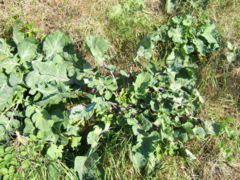Brassica oleracea
| Brassica oleracea {{{status}}} Fossil range: {{{fossil_range}}}
| ||||||||||||||||||||||||||||||||||||||||||||||||||||||||||||||||||
|---|---|---|---|---|---|---|---|---|---|---|---|---|---|---|---|---|---|---|---|---|---|---|---|---|---|---|---|---|---|---|---|---|---|---|---|---|---|---|---|---|---|---|---|---|---|---|---|---|---|---|---|---|---|---|---|---|---|---|---|---|---|---|---|---|---|---|
 Wild Cabbage plants | ||||||||||||||||||||||||||||||||||||||||||||||||||||||||||||||||||
| Plant Info | ||||||||||||||||||||||||||||||||||||||||||||||||||||||||||||||||||
| ||||||||||||||||||||||||||||||||||||||||||||||||||||||||||||||||||
| Scientific classification | ||||||||||||||||||||||||||||||||||||||||||||||||||||||||||||||||||
| ||||||||||||||||||||||||||||||||||||||||||||||||||||||||||||||||||
| [[{{{diversity_link}}}|Diversity]] | ||||||||||||||||||||||||||||||||||||||||||||||||||||||||||||||||||
| {{{diversity}}} | ||||||||||||||||||||||||||||||||||||||||||||||||||||||||||||||||||
| Binomial name | ||||||||||||||||||||||||||||||||||||||||||||||||||||||||||||||||||
| Brassica oleracea L. | ||||||||||||||||||||||||||||||||||||||||||||||||||||||||||||||||||
| Trinomial name | ||||||||||||||||||||||||||||||||||||||||||||||||||||||||||||||||||
| {{{trinomial}}} | ||||||||||||||||||||||||||||||||||||||||||||||||||||||||||||||||||
| Type Species | ||||||||||||||||||||||||||||||||||||||||||||||||||||||||||||||||||
| {{{type_species}}} | ||||||||||||||||||||||||||||||||||||||||||||||||||||||||||||||||||
| {{{subdivision_ranks}}} | ||||||||||||||||||||||||||||||||||||||||||||||||||||||||||||||||||
| [[Image:{{{range_map}}}|{{{range_map_width}}}|]] | ||||||||||||||||||||||||||||||||||||||||||||||||||||||||||||||||||
| Synonyms | ||||||||||||||||||||||||||||||||||||||||||||||||||||||||||||||||||
| {{{synonyms}}} |
Brassica oleracea or Wild Cabbage, is a species of Brassica native to coastal southern and western Europe, where its tolerance of salt and lime but intolerance of competition from other plants typically restricts its natural occurrence to limestone sea cliffs.
Wild B. olearacea is a tall biennial plant, forming a stout rosette of large leaves in the first year, the leaves being fleshier and thicker than those of other species of Brassica, adaptations to store water and nutrients in its difficult growing environment. In its second year, the stored nutrients are used to produce a flower spike 1–2 m tall bearing numerous yellow flowers.
Cultivation and uses
Although B. oleracea is believed to have been cultivated for several thousand years, its history as a domesticated plant is not clear before Greek and Roman times, when is known to be a well-established garden vegetable. Theophrastus mentions three kinds of this species: a curly-leaved, a smooth-leaved, and a wild-type.[1] It has been bred into a wide range of cultivars, including cabbage, broccoli, cauliflower, and more, some of which are hardly recognisable as being members of the same species. It is one of the most important human food crop plants. According to the Triangle of U theory, B. oleracea is very closely related to five other species of the genus Brassica.
The plant is used because of its large food reserves, which are stored over the winter in its leaves. It is rich in essential nutrients including vitamin C.
The cultivars of B. oleracea are grouped by developmental form into seven major cultivar groups, of which the Acephala Group remains most like the natural Wild Cabbage in appearance:
- Brassica oleracea Acephala Group - kale and collard greens (borekale)
- Brassica oleracea Alboglabra Group - kai-lan (Chinese broccoli)
- Brassica oleracea Botrytis Group - cauliflower (and Chou Romanesco)
- Brassica oleracea Capitata Group - cabbage
- Brassica oleracea Gemmifera Group - Brussels sprouts
- Brassica oleracea Gongylodes Group - kohlrabi
- Brassica oleracea Italica Group - broccoli
Some (notably Brussels sprouts and broccoli) contain high levels of sinigrin which is thought to help prevent bowel cancer.
For other edible plants in the family Brassicaceae, see cruciferous vegetables.

Notes
- ↑ Daniel Zohary and Maria Hopf, Domestication of plants in the Old World, third edition (Oxford: Oxford University Press, 2000), p. 199.